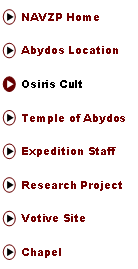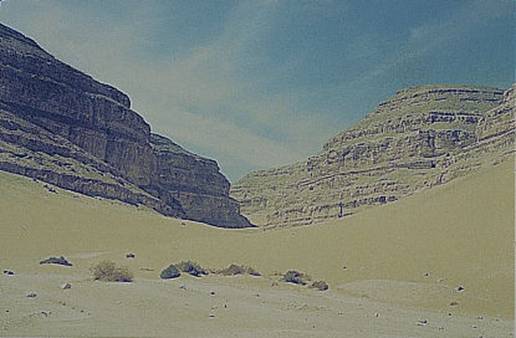




|
Menu |
|
Abydos and the Cult of Osiris
The importance of Abydos as a sacred center can be traced to its primacy as the burial place of the rulers of a late prehistoric "proto-kingdom" and the first historically attested rulers of a politically united Egyptian state. The tombs of these rulers at a site known as Umm el-Ga'ab (a phrase meaning "Mother of Potsherds" in colloquial Egyptian Arabic) are located at the base of the high desert, near the entrance to a deep natural wadi that cuts through the limestone cliffs and extends down to the cultivation. The site of Umm el-Ga’ab is being studied by the German Archaeological Institute, under the direction of Dr. Günter Dreyer.
Massive mud brick funerary enclosures associated with the Early Dynastic kings of Egypt were constructed in the area called the North Cemetery. The only funerary enclosure whose superstructure is now preserved, known locally as the Shunet ez-Zebib, is that of the late Second Dynasty ruler Khasekhemwy. These structures are currently under investigation by the University of Pennsylvania-Yale-Institute of Fine Arts, New York University Expedition under the direction of Dr. David O’Connor and Dr. William Kelly Simpson. The North Cemetery was used for the burial of non-royal individuals from the Middle Kingdom onward. On the other side of the wadi lies the Middle Cemetery, the location of elite Old Kingdom tombs as well as later burials. To the local south are the temple of Seti I, and in South Abydos, the mortuary complex and town site of Senwosret III and the pyramid complex of Ahmose I. These areas are under investigation by sub-projects under the auspices of the University of Pennsylvania-Yale-Institute of Fine Arts, New York University Expedition to Abydos. |

|
The Great Wadi at Abydos |
|
Home | Location | Osiris Cult | Temple | Staff | Research | Site | Votive Chapel |


|
North Abydos Votive Zone Project |
|
Copyright © 2006 Department of Near & Middle Eastern Civilizations, University of Toronto. All rights reserved. |